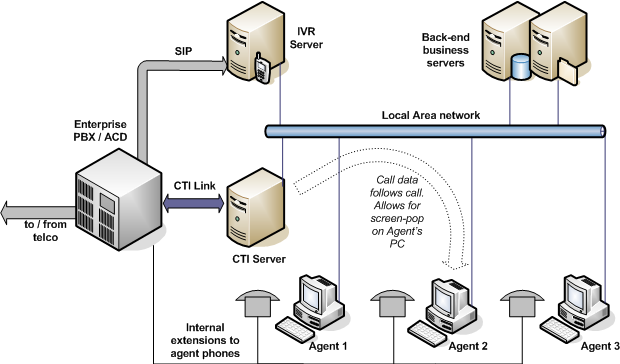
Computer Telephony Integration (CTI) is the specific integration of communication between a call-centre's data network and the PBX/ACD
A CTI enabled system will normally involve the deployment of a CTI Server which communicates with a sophisticated enterprise-grade PBX to deliver information about telephony events to applications running on users' or agents' computers. Events will be raised in agent's PC's CTI application when an incoming call arrives at an agent's phone. This information will include call data, such as CLI and DDI information as well as a unique call identifier. Therefore, if the agent then transfers the call to a colleague - even if that call had been routed via a queue - then, on arrival at the colleague's phone, the colleague's PC will receive the same call details. This is known as a 'screen pop' and this simple process allows the caller's details to be passed from PC to PC together with the transferred call.
The architecture of eurovoice objects toolkit makes it easy to integrate IVR functionality with 3rd party CTI products. This powerful combination of technologies allows businesses to implement seamless hand-over between automated systems and agents, and vice-versa; it is probably best explained with a sample from the insurance / financial services sector:-
· Incoming calls to a financial business are answered directly by the IVR system, 24 hours a day.
· The IVR system, located behind an Avaya PBX/ACD, receives not only the call, but the DDI and CLI information via the CTI link.
· The DDI information is used to determine how the caller is greeted - this site handles calls for different products.
· The CLI information is used to check whether this is a regular caller. Regular callers are allowed to enter just the last 4 digits of their card number for speed.
· The caller identifies themselves and passes through appropriate security checks.
· They are told their current balance and account status.
· A range of other services are available, such as the ability to make payments, hear latest transactions on their account etc.
· If the caller opts to speak to a live agent, the call is transferred to an ACD queue.
· Simultaneously, information about their call (who they are, whether they got past security, where in the dialogue they requested a transfer etc) is written to a temporary business database, with the CTI call reference number as a unique identifier.
· When the call is delivered to an available call-centre agent, their screen is completed with all the caller's details that have been processed in the IVR.
· The agent is therefore able to seamlessly continue with the transaction where the IVR left off.
The combination of CTI and IVR has significant business benefits:-
· Callers are not frustrated by having to repeat information (e.g. the purpose of their call).
· Callers do not have to repeat security information.
· Agent call-times are significantly reduced.
· Calls may be transferred back to the IVR to disseminate routine information.
